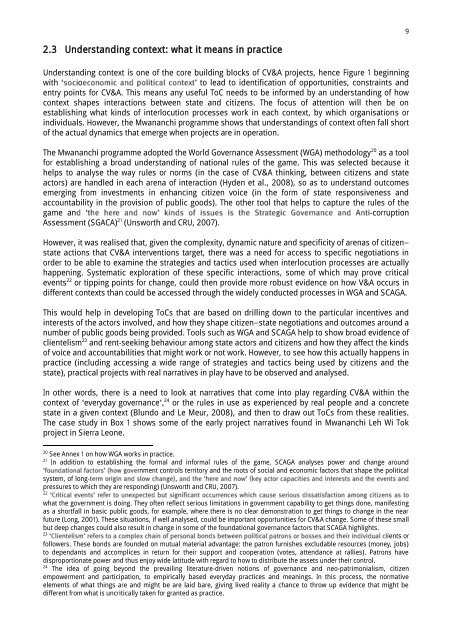Citizen voice and state accountability: Towards ... - Capacity4Dev
Citizen voice and state accountability: Towards ... - Capacity4Dev
Citizen voice and state accountability: Towards ... - Capacity4Dev
- No tags were found...
You also want an ePaper? Increase the reach of your titles
YUMPU automatically turns print PDFs into web optimized ePapers that Google loves.
92.3 Underst<strong>and</strong>ing context: what it means in practiceUnderst<strong>and</strong>ing context is one of the core building blocks of CV&A projects, hence Figure 1 beginningwith o to lead to identification of opportunities, constraints <strong>and</strong>entry points for CV&A. This means any useful ToC needs to be informed by an underst<strong>and</strong>ing of howcontext shapes interactions between <strong>state</strong> <strong>and</strong> citizens. The focus of attention will then be onestablishing what kinds of interlocution processes work in each context, by which organisations orindividuals. However, the Mwananchi programme shows that underst<strong>and</strong>ings of context often fall shortof the actual dynamics that emerge when projects are in operation.The Mwananchi programme adopted the World Governance Assessment (WGA) methodology 20 as a toolfor establishing a broad underst<strong>and</strong>ing of national rules of the game. This was selected because ithelps to analyse the way rules or norms (in the case of CV&A thinking, between citizens <strong>and</strong> <strong>state</strong>actors) are h<strong>and</strong>led in each arena of interaction (Hyden et al., 2008), so as to underst<strong>and</strong> outcomesemerging from investments in enhancing citizen <strong>voice</strong> (in the form of <strong>state</strong> responsiveness <strong>and</strong><strong>accountability</strong> in the provision of public goods). The other tool that helps to capture the rules of thegame an-corruptionAssessment (SGACA) 21 (Unsworth <strong>and</strong> CRU, 2007).However, it was realised that, given the complexity, dynamic nature <strong>and</strong> specificity of arenas of citizen<strong>state</strong> actions that CV&A interventions target, there was a need for access to specific negotiations inorder to be able to examine the strategies <strong>and</strong> tactics used when interlocution processes are actuallyhappening. Systematic exploration of these specific interactions, some of which may prove criticalevents 22 or tipping points for change, could then provide more robust evidence on how V&A occurs indifferent contexts than could be accessed through the widely conducted processes in WGA <strong>and</strong> SCAGA.This would help in developing ToCs that are based on drilling down to the particular incentives <strong>and</strong>interests of the actors involved, <strong>and</strong> how they shape citizen <strong>state</strong> negotiations <strong>and</strong> outcomes around anumber of public goods being provided. Tools such as WGA <strong>and</strong> SCAGA help to show broad evidence ofclientelism 23 <strong>and</strong> rent-seeking behaviour among <strong>state</strong> actors <strong>and</strong> citizens <strong>and</strong> how they affect the kindsof <strong>voice</strong> <strong>and</strong> accountabilities that might work or not work. However, to see how this actually happens inpractice (including accessing a wide range of strategies <strong>and</strong> tactics being used by citizens <strong>and</strong> the<strong>state</strong>), practical projects with real narratives in play have to be observed <strong>and</strong> analysed.In other words, there is a need to look at narratives that come into play regarding CV&A within thecontext of everyday governance 24 or the rules in use as experienced by real people <strong>and</strong> a concrete<strong>state</strong> in a given context (Blundo <strong>and</strong> Le Meur, 2008), <strong>and</strong> then to draw out ToCs from these realities.The case study in Box 1 shows some of the early project narratives found in Mwananchi Leh Wi Tokproject in Sierra Leone.20See Annex 1 on how WGA works in practice.21In addition to establishing the formal <strong>and</strong> informal rules of the game, SCAGA analyses power <strong>and</strong> change aroundnment controls territory <strong>and</strong> the roots of social <strong>and</strong> economic factors that shape the politicalsystem, of longpressuresto which they are responding) (Unsworth <strong>and</strong> CRU, 2007).22what the government is doing. They often reflect serious limitations in government capability to get things done, manifestingas a shortfall in basic public goods, for example, where there is no clear demonstration to get things to change in the nearfuture (Long, 2001). These situations, if well analysed, could be important opportunities for CV&A change. Some of these smallbut deep changes could also result in change in some of the foundational governance factors that SCAGA highlights.23ients orfollowers. These bonds are founded on mutual material advantage: the patron furnishes excludable resources (money, jobs)to dependants <strong>and</strong> accomplices in return for their support <strong>and</strong> cooperation (votes, attendance at rallies). Patrons havedisproportionate power <strong>and</strong> thus enjoy wide latitude with regard to how to distribute the assets under their control.24The idea of going beyond the prevailing literature-driven notions of governance <strong>and</strong> neo-patrimonialism, citizenempowerment <strong>and</strong> participation, to empirically based everyday practices <strong>and</strong> meanings. In this process, the normativeelements of what things are <strong>and</strong> might be are laid bare, giving lived reality a chance to throw up evidence that might bedifferent from what is uncritically taken for granted as practice.
















